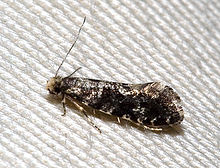Nemapogon granella
Appearance
| European grain moth | |
|---|---|

| |
| Adult from Dresden (Germany) | |
| Scientific classification | |
| Domain: | Eukaryota |
| Kingdom: | Animalia |
| Phylum: | Arthropoda |
| Class: | Insecta |
| Order: | Lepidoptera |
| Family: | Tineidae |
| Genus: | Nemapogon |
| Species: | N. granella
|
| Binomial name | |
| Nemapogon granella | |
| Synonyms | |
|
Numerous, see text | |
Nemapogon granella (European grain worm or European grain moth) is a
junior objective synonyms of Nemapogon.[1]
Ecology and description
This
synanthropic moth has been distributed essentially all over the globe, though many such introduced populations are not stable for long periods of time. Still, it is regularly found in Australia for example, about as far away from its native range as is possible on Earth. The adults are most often seen throughout the summer months, e.g. from March to September in the UK. Naturally, populations associated with humans can be encountered at any time of the year.[3]

This small moth has a wingspan of 10–18 mm. The forewings are irregularly mottled black, white and grey, resembling
cork moth (N. cloacella). They have a row of large black spots on the leading edge, which merge with spots within the wing to form a rough band zigzagging along the length of the forewings. The hindwings are uniformly greyish-brown and surrounded by a fringe of long hairs. On the head, the adults have a tuft of yellowish-white hairs.[4]
The
birch polypore (Piptoporus betulinus). But they have also been found on Serpula lacrymans of the quite unrelated Boletales.[5]
Larvae in association with humans will feed on a variety of dry organic material, such as
bitter almonds (Prunus amygdalus amara) and beeswax, but it is not clear if they refer to this species or the cork moth.[5]
Synonyms
This widespread, often common and partially
Junior synonyms and other obsolete scientific names of the European grain moth are:[6]

- Nemapogon costotristrigella (Chambers, 1873)
- Nemapogon costistrigella (lapsus)
- Nemapogon domesticella (Scopoli, 1763)
- Nemapogon fascomaculella (lapsus)
- Nemapogon fenestrella (Scopoli, 1763b) (non Scopoli, 1763a: preoccupied)
- Nemapogon fuscicomella (Wörz, 1958)
- Nemapogon fuscomaculella (Chambers, 1873[verification needed])
- Nemapogon granellus (lapsus)
- Nemapogon mancuniella (Hodgkinson, 1880)
- Nemapogon marmorella (Chambers, 1875[verification needed])
- Nemapogon nebulosella (Geoffroy in Fourcroy, 1785)
- Nemapogon granella nigra (Dufrane, 1955)
- Nemapogon nigroatomella (Dietz, 1905)
- Nemapogon tesserella (Fabricius, 1794)
- Phalaena domesticella Scopoli, 1763
- Phalaena fenestrellaScopoli, 1763b (non Scopoli, 1763a: preoccupied)
- Phalaena (Tinea) granella Linnaeus, 1758
- Tinea costotristrigella Chambers, 1873
- Tinea fuscicomella Wörz, 1958
- Tinea fuscomaculella Chambers, 1873[verification needed]
- Tinea granella Linnaeus, 1758
- Tinea granella nigra Dufrane, 1955
- Tinea mancuniella Hodgkinson, 1880
- Tinea marmorella Chambers, 1875[verification needed]
- Tinea nebulosella Geoffroy in Fourcroy, 1785
- Tinea nigroatomella Dietz, 1905
- Tinea tesserella Fabricius, 1794
The supposed subspecies nigra form Belgium has turned out to be a chance form, rather than a distinct population.[6]
Footnotes
References
- Australian Biological Resources Study (ABRS) (2008a): Australian Faunal Directory – Nemapogon. Version of 2008-OCT-09. Retrieved 2010-MAY-06.
- Australian Biological Resources Study (ABRS) (2008b): Australian Faunal Directory – Nemapogon granella. Version of 2008-OCT-09. Retrieved 2010-MAY-06.
- Fauna Europaea (FE) (2009): Nemapogon granella. Version 2.1, 2009-DEC-22. Retrieved 2010-MAY-06.
- Grabe, Albert (1942): Eigenartige Geschmacksrichtungen bei Kleinschmetterlingsraupen ["Strange tastes among micromoth caterpillars"]. Zeitschrift des Wiener Entomologen-Vereins 27: 105-109 [in German]. PDF fulltext
- Kimber, Ian [2010]: UKmoths – Nemapogon granella. Retrieved 2010-MAY-06.
- Pitkin, Brian & Jenkins, Paul (2004a): Butterflies and Moths of the World, Generic Names and their Type-species – Brosis Hübner, 1822. Version of 2004-NOV-05. Retrieved 2010-MAY-06.
- Pitkin, Brian & Jenkins, Paul (2004b): Butterflies and Moths of the World, Generic Names and their Type-species – Diaphthirusa. Version of 2004-NOV-05. Retrieved 2010-MAY-06.
- Pitkin, Brian & Jenkins, Paul (2004c): Butterflies and Moths of the World, Generic Names and their Type-species – Nemapogon. Version of 2004-NOV-05. Retrieved 2010-MAY-06.
- Robinson, Gaden S. [2010]: Global Taxonomic Database of Tineidae (Lepidoptera) – Nemapogon granella. Retrieved 2010-MAY-06.
- Savela, Markku (2003): Markku Savela's Lepidoptera and some other life forms – Nemapogon granella [sic]. Version of 2003-DEC-27. Retrieved 2010-MAY-06.
External links
American Cyclopædia article Wheat Moth
.